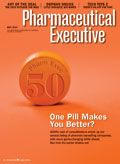Weathering the Compliance Storm
Timely and accessible information can help break through the firewall of regulation.
Sales force field teams are slashed 30, 40, or 50 percent while territories mushroom. New competitors emerge, and everyone is required to do more with less. Physicians limit access, and eventually close their doors—for good. Now, another roadblock has resurfaced, and it's bigger than ever: compliance.

Matt Wallach
Compliance used to be an issue that primarily affected Sample Operations, Quality Assurance, and Manufacturing; but now the concern is enterprise-wide. And it's not a simple case of creating a new SOP. Today, compliance is a moving target; the rules change as often as the weather.
Handicapped by Sunshine
Consider aggregate state expenditure compliance. Six states and Washington, DC, have enacted legislation mandating life sciences companies to track and disclose their sales and marketing expenditures on physicians, and at least 20 states have introduced similar legislation. However, each of these states has different reporting requirements and defines soft-dollar spending in different ways. Some have already changed these complicated regulations more than once. Soon, the Federal Sunshine Act will add another layer of complexity to the situation.
Off-label product promotion is another (more costly) example of how unexpected changes in regulatory weather patterns can affect sales. Who can forget the PhRMA litigations over off-label product promotion in 2009? Certainly not Pfizer, AstraZeneca, and Eli Lilly, each of which were each slammed with hefty fines. According to the Wall Street Journal, AstraZeneca is set to pay $520 million on its antipsychotic Seroquel claims, which is just a fraction of the cost of off-label promotion settlements at Eli Lilly ($1.4 billion) and Pfizer ($2.3 billion).
The effect of these and so many other confusing and constantly changing rules can paralyze sales forces, destroy morale, and ultimately detract from performance. Understandably, reps become more hesitant, which is a huge handicap in today's fiercely competitive market. Even the best sales reps, who are typically fast-acting and opportunistic, can become agonizingly cautious in the face of these obstacles. And when the very traits that once defined a skilled sales person begin to fade, your market dominance will do the same.
How can companies keep their sales teams strong enough to weather any compliance storm?
Better Training and New Tools
Life sciences sales teams require even more training than in years past. Ten years ago, reps were trained on a small range of products once or twice a year. Today, they must know how to detail three times as many products, which can change every quarter. In addition, reps must learn complex selling strategies based on formulary position; how to work with physicians given their patients' payer mix; aggregate state expenditure compliance rules; off-label product promotion restrictions; and more.
The good news is that training reps on all this material with a limited budget is simpler than you might think. Just use the latest technology. New training tools built on flexible architectures like software-as-a-service (SaaS) allow life sciences companies to train salespeople efficiently via the Web. Cisco's WebEx,for example, offers a SaaS application that delivers dynamic, interactive training to employees anywhere in the world. Sales managers can share visual content in real time; participants conference in by phone, so they all see and hear the whole demonstration as it happens. Because it's a SaaS application, there's no hardware to buy or software to install, and upgrades are included. Its multi-tenant architecture enables unparalleled scalability, flexibility, and efficiency.
Multi-tenant SaaS applications are built to serve multiple customers from a single, shared application. In the same way a multi-tenant apartment building provides the advantages of economies of scale (i.e., higher powered HVAC systems, industrial-strength elevators, grounds staff, etc), so do multi-tenant SaaS applications. Customers don't have to worry about maintaining the system, they just have to focus on making it fit their requirements, including any specific needs that will help ensure compliance.
With 10 million users globally, including new users at AstraZeneca, Plateau offers a SaaS training system that enhances the experience for companies of all sizes. This learning management system's SaaS platform enables it to provide customers with curricula that can be changed as quickly as compliance rules.
In addition to advanced training systems, there are a number of other technology tools, such as closed loop marketing (CLM), that can help sales reps shoulder the heavy burden of regulatory compliance. Used in conjunction with a SaaS customer relationship management (CRM) or sales force automation (SFA) system, CLM tools allow companies to control all of the content physicians see, making compliance much less of a burden on salespeople.
Exploria SPS offers a SaaS CLM system that integrates with CRM systems to allow brand and sales teams to customize messaging to every physician in every interaction. A business-rule-driven CLM program within a flexible CRM system gives sales teams the power to create customer details for individual physicians that can be changed as often as necessary to incorporate new information.
That's powerful stuff—especially when that new information happens to be the FDA's "regulation of the week." In fact, the Wall Street Journal recently reported that Pfizer is rolling out a SaaS CRM/CLM system that includes parameters designed to ensure that sales reps are appropriately distributing drug samples, discussing products, and handling physician requests for medical information. The new system is expected to guide reps when detailing products, so that they know exactly which samples can be signed for, and what content can be shown to a physician based on his or her specialty and the approved uses of the company's medicines. Because the new system is built on the popular cloud computing model, all of this information can be changed as often as needed to reflect changes in compliance regulations.
Technology That's Built for Change
Arguably the greatest weapon in life sciences sales reps' arsenal is the CRM system itself. But in order for it to make a serious impact, it must be designed to change on a dime. As reps' jobs change, as their organizations change, as their territories change, as the products they detail change, and as regulations change, the CRM system must change, too. Even as sales teams splinter into smaller specialty teams—managed markets account executives, hospital account sales, key opinion leader managers—they will need a system that can adapt to the many different functions of the modern-day pharmaceutical sales professional.
Unfortunately, most CRM systems currently on the market are not built for change. Most are client/server relics. Trying to add new functionality, realign territories, modify regulatory reports—or make any other changes to these systems—is like trying to move a mountain with a wheelbarrow. It takes too long, requires too much effort, and costs too much. And when it comes to compliance, by the time you finally complete a change, chances are it's already obsolete.
By contrast, multi-tenant SaaS CRM applications release new features and functionality to their customers every few months. If federal regulations or guidelines change tomorrow, SaaS CRM users will be prepared to comply well ahead of impending deadlines without having to suffer through the traditional upgrade process. Mobile users also benefit: Because all upgrades are pushed to customers via the Web, mobile devices are upgraded seamlessly when users sync—it takes mere seconds.
Only SaaS CRM applications based on the cloud-computing model are uniquely designed to be able to change as frequently as regulations change. Applications running in the cloud allow for instant, behind-the-scenes upgrades for their customers. System changes necessary to support regulatory compliance requirements can be made and pushed out to customers through these regular, free upgrades.
However, buyer beware: not all SaaS systems are created equal. The tremendous marketing efforts to brand "SaaS" and "in the cloud" have made these terms table stakes for all vendors. As a result, some software providers are abusing the terminology. In reality, many of these products are just cleverly disguised as SaaS, but in reality are shackled by all the same costs and limitations as outdated client/server and hosted solutions. Be sure that your system is multi-tenant to strengthen your sales team with the full power of SaaS technology.
Matt Wallach is executive vice president and general manager of Veeva Systems. He can be reached at matt.wallach@veevasystems.com

The Misinformation Maze: Navigating Public Health in the Digital Age
March 11th 2025Jennifer Butler, chief commercial officer of Pleio, discusses misinformation's threat to public health, where patients are turning for trustworthy health information, the industry's pivot to peer-to-patient strategies to educate patients, and more.
Navigating Distrust: Pharma in the Age of Social Media
February 18th 2025Ian Baer, Founder and CEO of Sooth, discusses how the growing distrust in social media will impact industry marketing strategies and the relationships between pharmaceutical companies and the patients they aim to serve. He also explains dark social, how to combat misinformation, closing the trust gap, and more.